Structures and Luminescent Sensing Properties of Terbium Metal–Organic Frameworks with Methyl-Decorated Phenanthroline Ligand
Abstract
1. Introduction
2. Materials and Methods
2.1. Materials
2.2. Instruments
2.3. Synthetic Methods
2.4. Single-Crystal X-Ray Diffraction Details
3. Results and Discussion
3.1. Synthesis and Crystal Structure
3.2. Characterization and Luminescent Properties of [Tb2(dmphen)2(NO3)2(chdc)2]·2DMF (2)
3.3. Sensing of Nitroaromatic Molecules by [Tb2(dmphen)2(NO3)2(chdc)2]·2DMF (2)
4. Conclusions
Supplementary Materials
Author Contributions
Funding
Data Availability Statement
Conflicts of Interest
Appendix A. Crystal Data
| Parameter | 1 | 2 |
|---|---|---|
| Chemical formula | C58H72N6O16Tb2 | C50H58N8O16Tb2 |
| Mr, g/mol | 1427.05 | 1344.88 |
| Crystal system | Triclinic, | Monoclinic |
| Space group | P¯1 | P21/c |
| a, Å | 10.4566(4) | 13.3993(4) |
| b, Å | 10.6951(4) | 17.2194(4) |
| c, Å | 14.3877(4) | 13.3169(4) |
| Temperature, K | 291 | 292 |
| α, ° | 109.538(3) | 90 |
| β, ° | 97.979(3) | 119.658(4) |
| γ, ° | 104.222(3) | 90 |
| V, Å3 | 1426.26(9) | 2670.05(16) |
| Z | 1 | 2 |
| D(calc.), g·cm−3 | 1.661 | 1.673 |
| μ, mm−1 | 2.54 | 2.70 |
| F(000) | 720 | 1344 |
| Crystal size, mm | 0.30 × 0.26 × 0.20 | 0.22 × 0.20 × 0.06 |
| θ range for data collection, ° | 2.07 ≤ θ ≤ 25.24 | 2.11 ≤ θ ≤ 25.24 |
| Index ranges | −12 ≤ h ≤ 12; −12 ≤ k ≤ 12; −17 ≤ l ≤ 17 | −16 ≤ h ≤ 16; −19 ≤ k ≤ 20; −16 ≤ l ≤ 16 |
| No. of reflections: measured/independent/observed [I > 2σ(I)] | 16,175/5226/4726 | 24,435/4894/4378 |
| Rint | 0.0379 | 0.0293 |
| Goodness-of-fit on F2 | 1.035 | 1.049 |
| Final R indices [I > 2σ(I)] | R1 = 0.0259; wR2 = 0.0633 | R1 = 0.0192; wR2 = 0.0445 |
| Final R indices [all data] | R1 = 0.0317; wR2 = 0.0655 | R1 = 0.0234; wR2 = 0.0463 |
| Largest diff. peak, hole, e/Å3 | 0.91, −0.54 | 0.71, −0.40 |
References
- Yaghi, O.M.; Jiang, H.; Alezi, D.; Eddaoudi, M. A reticular chemistry guide for the design of periodic solids. Nat. Rev. Mater. 2021, 6, 466–487. [Google Scholar] [CrossRef]
- Ha, J.; Lee, J.H.; Moon, H.R. Alterations to secondary building units of metal–organic frameworks for the development of new functions. Inorg. Chem. Front. 2020, 7, 12–27. [Google Scholar] [CrossRef]
- Wang, Q.; Yang, L.; Ke, T.; Hu, J.; Suo, X.; Cui, X.; Xing, H. Selective sorting of hexane isomers by anion-functionalized metal-organic frameworks with optimal energy regulation. Nat. Commun. 2024, 15, 2620. [Google Scholar] [CrossRef]
- Yuvaraj, A.R.; Jayarama, A.; Sharma, D.; Nagarkar, S.S.; Duttagupta, S.P.; Pinto, R. Role of metal-organic framework in hydrogen gas storage: A critical review. Int. J. Hydrogen Energy 2024, 59, 1434–1458. [Google Scholar] [CrossRef]
- Liu, S.; Zhang, Y.; Zhu, F.; Liu, J.; Wan, X.; Liu, R.; Liu, X.; Shang, J.-X.; Yu, R.; Feng, Q.; et al. Mg-MOF-74 Derived Defective Framework for Hydrogen Storage at Above-Ambient Temperature Assisted by Pt Catalyst. Adv. Sci. 2024, 11, 2401868. [Google Scholar] [CrossRef]
- Xie, X.-J.; Zeng, H.; Lu, W.; Li, D. Metal–organic frameworks for hydrocarbon separation: Design, progress, and challenges. J. Mater. Chem. A 2023, 11, 20459–20469. [Google Scholar] [CrossRef]
- Firooz, S.K.; Armstrong, D.W. Metal-organic frameworks in separations: A review. Anal. Chim. Acta 2022, 1234, 340208. [Google Scholar] [CrossRef]
- Yang, G.-L.; Jiang, X.-L.; Xu, H.; Zhao, B. Applications of MOFs as Luminescent Sensors for Environmental Pollutants. Small 2021, 17, 2005327. [Google Scholar] [CrossRef] [PubMed]
- Kumar, A.; Kataria, R. MOFs as versatile scaffolds to explore environmental contaminants based on their luminescence bustle. Sci. Total Environ. 2024, 926, 172129. [Google Scholar] [CrossRef]
- Khatua, S.; Biswas, P. Flexible Luminescent MOF: Trapping of Less Stable Conformation of Rotational Isomers, In Situ Guest-Responsive Turn-Off and Turn-On Luminescence and Mechanistic Study. ACS Appl. Mater. Interfaces 2020, 12, 22335–22346. [Google Scholar] [CrossRef]
- Blake, A.J.; Champness, N.R.; Hubberstey, P.; Li, W.-S.; Withersby, M.A.; Schröder, M. Inorganic crystal engineering using self-assembly of tailored building-blocks. Coord. Chem. Rev. 1999, 183, 117–138. [Google Scholar] [CrossRef]
- Férey, G. Building Units Design and Scale Chemistry. J. Solid State Chem. 2000, 152, 37–48. [Google Scholar] [CrossRef]
- Millange, F.; Walton, R.I. MIL-53 and its Isoreticular Analogues: A Review of the Chemistry and Structure of a Prototypical Flexible Metal-Organic Framework. Isr. J. Chem. 2018, 58, 1019–1035. [Google Scholar] [CrossRef]
- Winarta, J.; Shan, B.; Mcintyre, S.M.; Ye, L.; Wang, C.; Liu, J.; Mu, B. A Decade of UiO-66 Research: A Historic Review of Dynamic Structure, Synthesis Mechanisms, and Characterization Techniques of an Archetypal Metal–Organic Framework. Cryst. Growth Des. 2020, 20, 1347–1362. [Google Scholar] [CrossRef]
- Mai, Z.; Liu, D. Synthesis and Applications of Isoreticular Metal–Organic Frameworks IRMOFs-n (n = 1, 3, 6, 8). Cryst. Growth Des. 2019, 19, 7439–7462. [Google Scholar] [CrossRef]
- Kitaura, R.; Seki, K.; Akiyama, G.; Kitagawa, S. Porous Coordination-Polymer Crystals with Gated Channels Specific for Supercritical Gases. Angew. Chem. Int. Ed. 2003, 42, 428–431. [Google Scholar] [CrossRef]
- Chun, H.; Dybtsev, D.N.; Kim, H.; Kim, K. Synthesis, X-ray Crystal Structures, and Gas Sorption Properties of Pillared Square Grid Nets Based on Paddle-Wheel Motifs: Implications for Hydrogen Storage in Porous Materials. Chem. Eur. J. 2005, 11, 3521–3529. [Google Scholar] [CrossRef] [PubMed]
- Dybtsev, D.N.; Yutkin, M.P.; Samsonenko, D.G.; Fedin, V.P.; Nuzhdin, A.L.; Bezrukov, A.A.; Bryliakov, K.P.; Talsi, E.P.; Belosludov, R.V.; Mizuseki, H.; et al. Modular, Homochiral, Porous Coordination Polymers: Rational Design, Enantioselective Guest Exchange Sorption and Ab Initio Calculations of Host–Guest Interactions. Chem. Eur. J. 2010, 16, 10348–10356. [Google Scholar] [CrossRef]
- Lysova, A.A.; Samsonenko, D.G.; Kovalenko, K.A.; Nizovtsev, A.S.; Dybtsev, D.N.; Fedin, V.P. A Series of Mesoporous Metal-Organic Frameworks with Tunable Windows Sizes and Exceptionally High Ethane over Ethylene Adsorption Selectivity. Angew. Chem. Int. Ed. 2020, 59, 20561–20567. [Google Scholar] [CrossRef]
- Lysova, A.A.; Samsonenko, D.G.; Dorovatovskii, P.V.; Lazarenko, V.A.; Khrustalev, V.N.; Kovalenko, K.A.; Dybtsev, D.N.; Fedin, V.P. Tuning the Molecular and Cationic Affinity in a Series of Multifunctional Metal–Organic Frameworks Based on Dodecanuclear Zn(II) Carboxylate Wheels. J. Am. Chem. Soc. 2019, 141, 17260–17269. [Google Scholar] [CrossRef]
- Manna, K.; Sutter, J.P.; Natarajan, S. Turn-off luminescence sensing, white light emission and magnetic studies of two-dimensional lanthanide MOFs. Dalton Trans. 2023, 52, 18449–18463. [Google Scholar] [CrossRef] [PubMed]
- Demakov, P.A.; Ryadun, A.A.; Dorovatovskii, P.V.; Lazarenko, V.A.; Samsonenko, D.G.; Brylev, K.A.; Fedin, V.P.; Dybtsev, D.N. Intense multi-colored luminescence in a series of rare-earth metal–organic frameworks with aliphatic linkers. Dalton Trans. 2021, 50, 11899–11908. [Google Scholar] [CrossRef] [PubMed]
- Pagis, C.; Ferbinteanu, M.; Rothenberg, G.; Tanase, S. Lanthanide-Based Metal Organic Frameworks: Synthetic Strategies and Catalytic Applications. ACS Catal. 2016, 6, 6063–6072. [Google Scholar] [CrossRef]
- Luo, A.-Y.; Lan, B.-L.; Shao, B.; Lu, X.-M.; Lan, Y.-F.; Liao, Y.-Z.; Zhang, Z. A 2D mixed-lanthanide metal–organic framework as dual-emitting luminescent sensor for ratiometric detection of tetracycline and nitrophenols. J. Mol. Struct. 2024, 1295, 136734. [Google Scholar] [CrossRef]
- Wang, S.; Macreadie, L.K.; Hanton, L.R. Pillared lanthanide metal organic frameworks with sinusoidal channels formed from bent mixed-donor phenanthroline based ligands of different length. CrystEngComm 2024, 26, 5541–5549. [Google Scholar] [CrossRef]
- Zhang, L.-Y.; Lu, L.-P.; Zhu, M.-L.; Si-Si Feng, S.-S. Self-assembly of lanthanide(iii) coordination polymers from a bifunctional 2-(pyridin-2-yl)-1H-imidazole-4,5-dicarboxylate ligand with the assistance of oxalate: Syntheses, structures, luminescence, and magnetic properties. CrystEngComm 2017, 19, 1953–1964. [Google Scholar] [CrossRef]
- Janicki, R.; Mondry, A.; Starynowicz, P. Carboxylates of rare earth elements. Coord. Chem. Rev. 2017, 340, 98–133. [Google Scholar] [CrossRef]
- Gorai, T.; Schmitt, W.; Gunnlaugsson, T. Highlights of the development and application of luminescent lanthanide based coordination polymers, MOFs and functional nanomaterials. Dalton Trans. 2021, 50, 770–784. [Google Scholar] [CrossRef]
- Demakov, P.A.; Vasileva, A.A.; Volynkin, S.S.; Ryadun, A.A.; Samsonenko, D.G.; Fedin, V.P.; Dybtsev, D.N. Cinnamal Sensing and Luminescence Color Tuning in a Series of Rare-Earth Metal−Organic Frameworks with Trans-1,4-cyclohexanedicarboxylate. Molecules 2021, 26, 5145. [Google Scholar] [CrossRef]
- Demakov, P.A.; Ryadun, A.A.; Fedin, V.P. Aliphatic-Bridged Early Lanthanide Metal–Organic Frameworks: Topological Polymorphism and Excitation-Dependent Luminescence. Inorganics 2022, 10, 163. [Google Scholar] [CrossRef]
- CrysAlisPro 1.171.38.46. Rigaku Oxford Diffraction: The Woodlands, TX, USA, 2015. Available online: https://www.rigaku.com/products/crystallography/crysalis (accessed on 13 October 2023).
- Sheldrick, G.M. SHELXT—Integrated space-group and crystal-structure determination. Acta Cryst. 2015, 71, 3–8. [Google Scholar] [CrossRef] [PubMed]
- Sheldrick, G.M. Crystal structure refinement with SHELXL. Acta Cryst. 2015, 71, 3–8. [Google Scholar] [CrossRef]
- Glasby, L.T.; Cordiner, J.L.; Cole, J.C.; Moghadam, P.Z. Topological Characterization of Metal–Organic Frameworks: A Perspective. Chem. Mater. 2024, 36, 9013–9030. [Google Scholar] [CrossRef] [PubMed]
- Noa, F.M.A.; Abrahamsson, M.; Ahlberg, E.; Cheung, O.; Göb, C.R.; Christine JMcKenzie, C.J.; Öhrström, L. A unified topology approach to dot-, rod-, and sheet-MOFs. Chem 2021, 7, 2491–2512. [Google Scholar] [CrossRef]
- Spek, A.L. PLATON SQUUEZE: A tool for the calculation of the disordered solvent contribution to the calculated structure factors. Acta Cryst. 2015, 71, 9–18. [Google Scholar] [CrossRef]
- He, H.; Sun, Q.; Gao, W.; Perman, J.A.; Sun, F.; Zhu, G.; Aguila, B.; Forrest, K.; Space, B.; Ma, S. A Stable Metal–Organic Framework Featuring a Local Buffer Environment for Carbon Dioxide Fixation. Angew. Chem. Int. Ed. 2018, 57, 4657–4662. [Google Scholar] [CrossRef]
- Xiao, Y.; Chen, Y.; Wang, W.; Yang, H.; Hong, A.N.; Bu, X.; Feng, P. Simultaneous Control of Flexibility and Rigidity in Pore-Space-Partitioned Metal–Organic Frameworks. J. Am. Chem. Soc. 2023, 145, 10980–10986. [Google Scholar] [CrossRef]
- Demakov, P.A. Properties of Aliphatic Ligand-Based Metal–Organic Frameworks. Polymers 2023, 15, 2891. [Google Scholar] [CrossRef]
- Murdock, C.R.; Hughes, B.C.; Lu, Z.; Jenkins, D.M. Approaches for synthesizing breathing MOFs by exploiting dimensional rigidity. Coord. Chem. Rev. 2014, 258–259, 119–136. [Google Scholar] [CrossRef]
- Xiaobo Yu, X.; Chang, W.; Cai, Z.; Cilin Yu, C.; Lai, L.; Zhou, Z.; Li, P.; Yang, Y.; Zeng, C. Hg2+ detection and information encryption of new [1+1] lanthanide cluster. Talanta 2024, 266, 125105. [Google Scholar] [CrossRef]
- Saleh, M.I.; Choo, M.Y.; Chan, T.W.; Razali, M.R. Effect of second ligand on the luminescence of Samarium (III) dibenzoylmethane complexes: Syntheses, crystal structures, thermal analysis and luminescence study. J. Chem. Sci. 2015, 127, 2241–2249. [Google Scholar] [CrossRef]
- Zhao, Z.-P.; Zheng, K.; Li, H.-R.; Zeng, C.-H.; Zhong, S.; Weng Ng, S.; Zheng, Y.; Chen, Y. Structure variation and luminescence of 3D, 2D and 1D lanthanide coordination polymers with 1,3-adamantanediacetic acid. Inorg. Chim. Acta 2018, 482, 340–346. [Google Scholar] [CrossRef]
- Yu, X.; Chang, W.; Zhang, H.; Cai, Z.; Yang, Y.; Zeng, C. Visual and Real-Time Monitoring of Cd2+ in Water, Rice, and Rice Soil with Test Paper Based on [2 + 2] Lanthanide Clusters. Inorg. Chem. 2023, 62, 6387–6396. [Google Scholar] [CrossRef] [PubMed]
- Pettinari, C.; Drozdov, A.; Belousov, Y. Coordination Compounds of Lanthanides as Materials for Luminescent Turn Off Sensors. In Rare Earth Elements—Emerging Advances, Technology Utilization, and Resource Procurement; IntechOpen: London, UK, 2022; Chapter 1; pp. 1–31. [Google Scholar]
- Bencini, A.; Lippolis, V. 1,10-Phenanthroline: A versatile building block for the construction of ligands for various purposes. Coord. Chem. Rev. 2010, 254, 2096–2180. [Google Scholar] [CrossRef]
- Sanzhenakova, E.A.; Smirnova, K.S.; Pozdnyakov, I.P.; Lider, E.V. Structural Features and Photoluminescence of Coordination Compounds Obtained in the Lanthanide(III) Acetate–1,10-Phenanthroline System in the Presence of 5-Phenyltetrazole. J. Struct. Chem. 2024, 65, 786–797. [Google Scholar] [CrossRef]
- Klein, A.; McInnes, E.J.L.; Kaim, W. Organometallic platinum(II) complexes of methyl-substituted phenanthrolines. J. Chem. Soc. Dalton Trans. 2002, 2371–2378. [Google Scholar] [CrossRef]
- Latva, M.; Takalo, H.; Mukkala, V.-M.; Matachescu, C.; Rodríguez-Ubis, J.C.; Kankare, J. Correlation between the lowest triplet state energy level of the ligand and lanthanide(III) luminescence quantum yield. J. Lumin. 1997, 75, 149–169. [Google Scholar] [CrossRef]
- Shmelev, M.A.; Chistyakov, A.S.; Razgonyaeva, G.A.; Voronina, J.K.; Varaksina, E.A.; Taydakov, I.V.; Sidorov, A.A.; Eremenko, I.L. Synthesis, Structure, and Photoluminescent Properties of Zn2+, Mn2+, Cd2+, Eu3+, and Tb3+ Complexes with 4-Allyl-2,3,5,6-Tetrafluorobenzoic Acid Anions and 1,10-Phenanthroline. J. Struct. Chem. 2024, 65, 362–380. [Google Scholar] [CrossRef]
- Hu, Z.; Deibert, B.; Li, J. Luminescent Metal–Organic Frameworks for Chemical Sensing and Explosive Detection. Chem. Soc. Rev. 2014, 43, 5815–5840. [Google Scholar] [CrossRef]
- Gole, B.; Bar, A.K.; Mukherjee, P.S. Multicomponent Assembly of Fluorescent-Tag Functionalized Ligands in Metal–Organic Frameworks for Sensing Explosives. Chem. Eur. J. 2014, 20, 13321–13336. [Google Scholar] [CrossRef]
- Sohn, H.; Sailor, M.J.; Magde, D.; Trogler, W.C. Detection of Nitroaromatic Explosives Based on Photoluminescent Polymers Containing Metalloles. J. Am. Chem. Soc. 2003, 125, 3821–3830. [Google Scholar] [CrossRef] [PubMed]
- Song, J.H.; Kang, D.W. Hazardous nitroaromatic explosives detection by emerging porous solid sensors. Coord. Chem. Rev. 2023, 492, 215279. [Google Scholar] [CrossRef]
- Haj-Yahya, A.; Kouskouki, D.; Margellou, A.G.; Andreou, E.K.; Armatas, G.S.; Lazarides, T. Functionalised Al(III) metal organic frameworks for fluorescence sensing of nitroaromatic vapours. J. Mater. Chem. C 2024, 12, 8014–8023. [Google Scholar] [CrossRef]
- Zhao, Y.-W.; Xue, B.; Zhang, N.; Guo, L.E.; Zhu, S.-Y.; Zhang, X.-M. Single-component rare-earth-free white light-emitting metal–organic framework towards nitroaromatic explosive sensing and dye adsorption. Inorg. Chem. Front. 2024, 11, 4826–4834. [Google Scholar] [CrossRef]
- Wang, Y.; Xiao, X.; Liu, J.; Dong, Z.; Wang, F.; Wang, X. White-Light-Emitting Ln-MOF as Luminescent Probe for Selective Detection of Nitroaromatic Compounds. Z. Anorg. Allg. Chem. 2024, 650, e202400084. [Google Scholar] [CrossRef]
- Panigrahi, S.K.; Mishra, A.K. Inner filter effect in fluorescence spectroscopy: As a problem and as a solution. J. Photochem. Photobiol. C Photochem. Rev. 2019, 41, 100318. [Google Scholar] [CrossRef]
- Chen, S.; Yu, Y.-L.; Wang, J.-H. Inner filter effect-based fluorescent sensing systems: A review. Anal. Chim. Acta 2018, 999, 13–26. [Google Scholar] [CrossRef]
- Sathiyan, G.; Venkatesan, G.; Ramasamy, S.K.; Lee, J.; Barathi, S. Recent progress in triazine-based fluorescent probes for detecting hazardous nitroaromatic compounds. J. Environ. Chem. Eng. 2024, 12, 112804. [Google Scholar] [CrossRef]
- Zhao, T.; Zhang, F.; Zhou, J.; Zhao, X. Luminescent Metal-Organic Frameworks for Nitroaromatic Compounds Detection. Comments Inorg. Chem. 2021, 41, 100–132. [Google Scholar] [CrossRef]
- Zhang, Y.; Yuan, S.; Day, G.; Wang, X.; Yang, X.; Zhou, H.-C. Luminescent sensors based on metal-organic frameworks. Coord. Chem. Rev. 2018, 354, 28–45. [Google Scholar] [CrossRef]
- Chen, X.-L.; Shang, L.; Liu, L.; Yang, H.; Cui, H.-L.; Wang, J.-J. A highly sensitive and multi-responsive Tb-MOF fluorescent sensor for the detection of Pb2+, Cr2O72−, B4O72−, aniline, nitrobenzene and cefixime. Dyes Pigm. 2021, 196, 109809. [Google Scholar] [CrossRef]
- Guo, H.; Wu, N.; Xue, R.; Liu, H.; Li, L.; Wang, M.-Y.; Yao, W.-Q.; Li, Q.; Yang, W. Multifunctional Ln-MOF luminescent probe displaying superior capabilities for highly selective sensing of Fe3+ and Al3+ ions and nitrotoluene. Colloids Surf. A Physicochem. Eng. Asp. 2020, 585, 124094. [Google Scholar] [CrossRef]
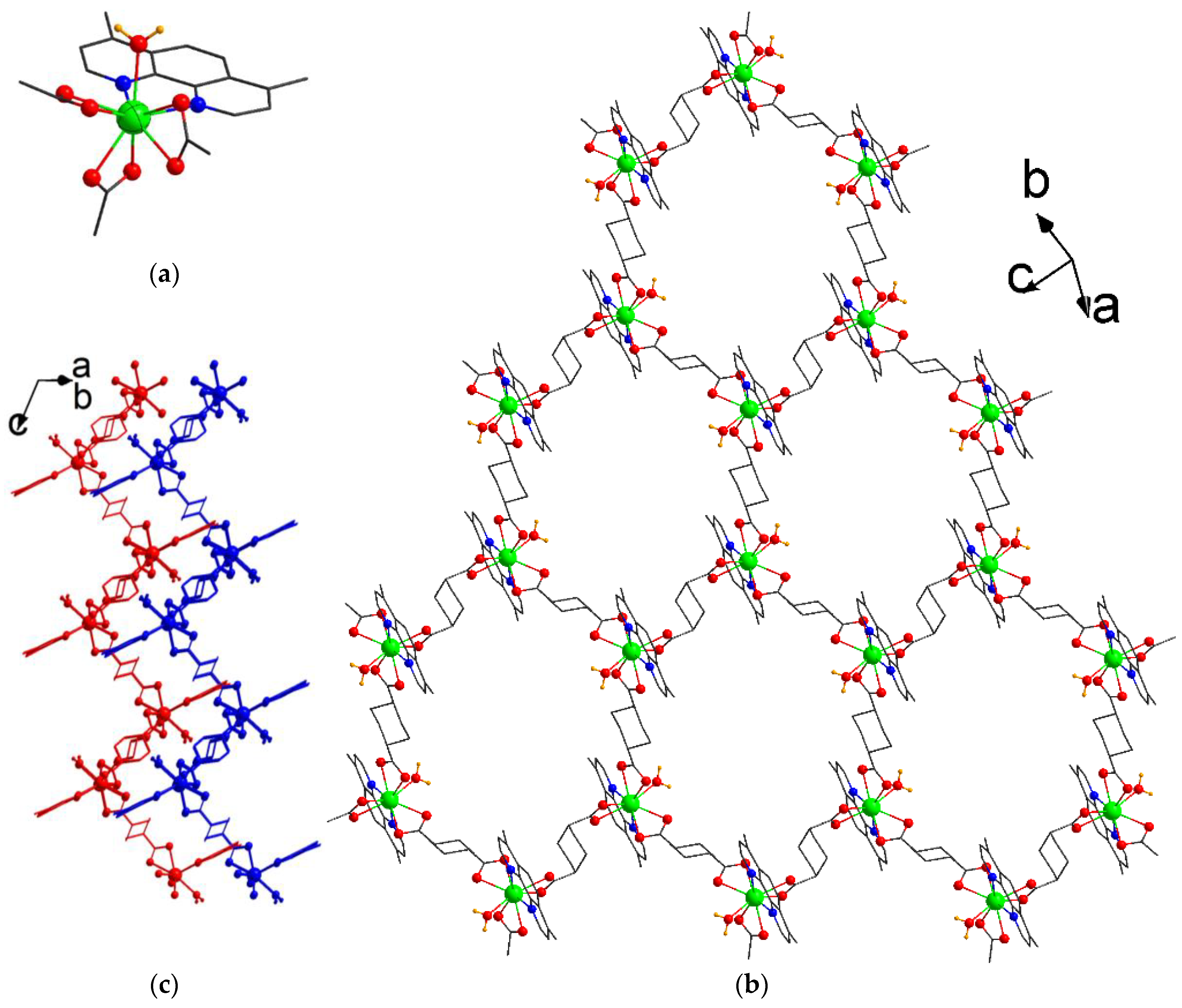
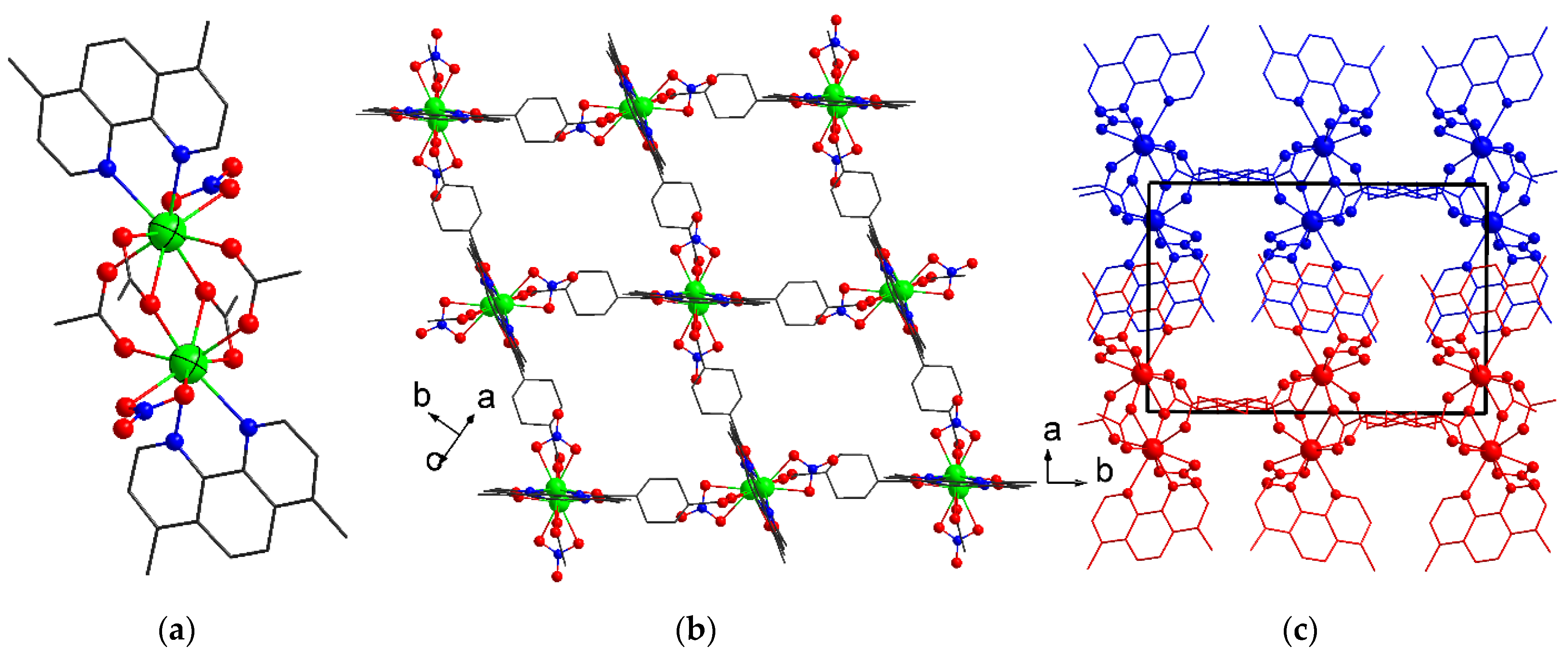

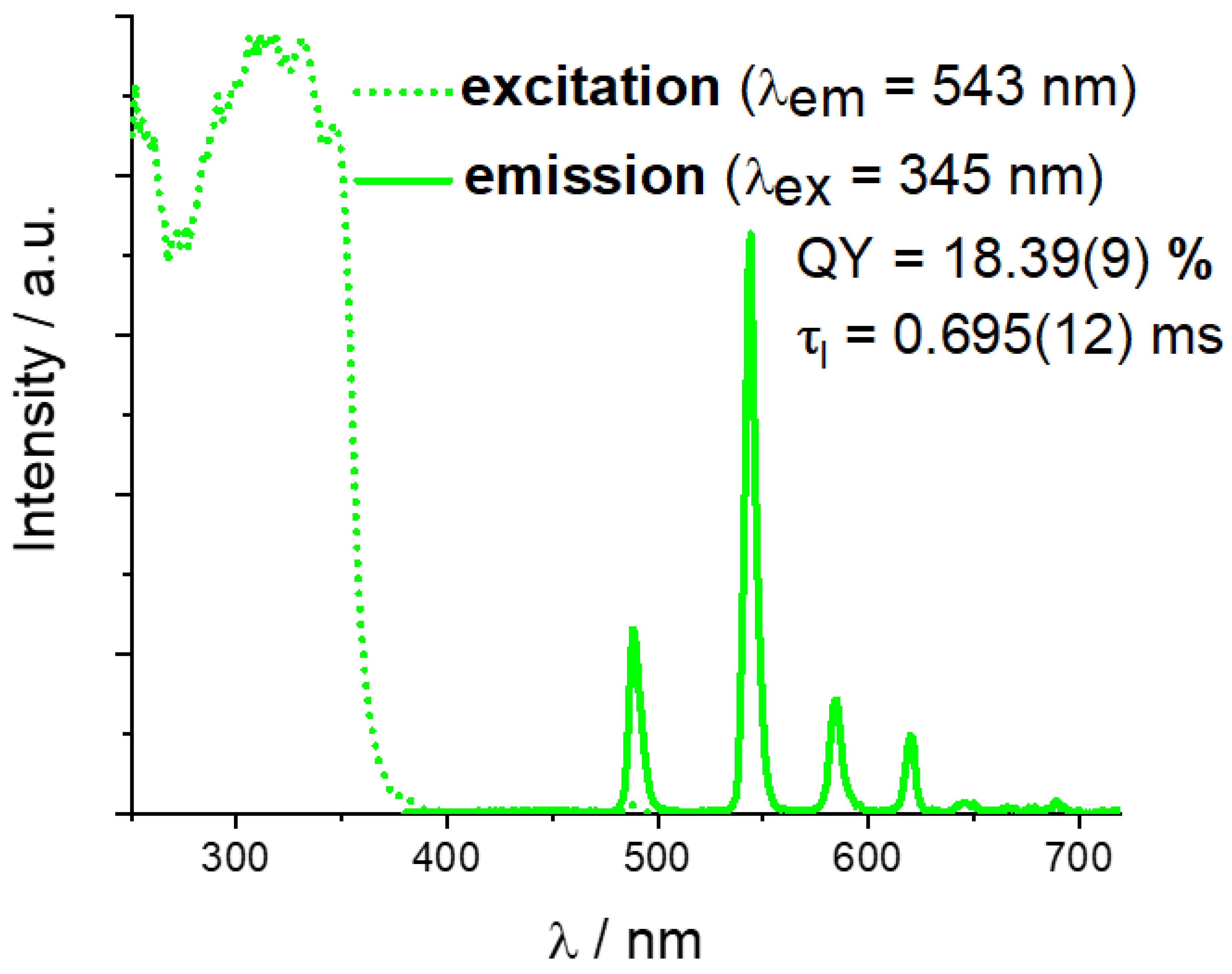
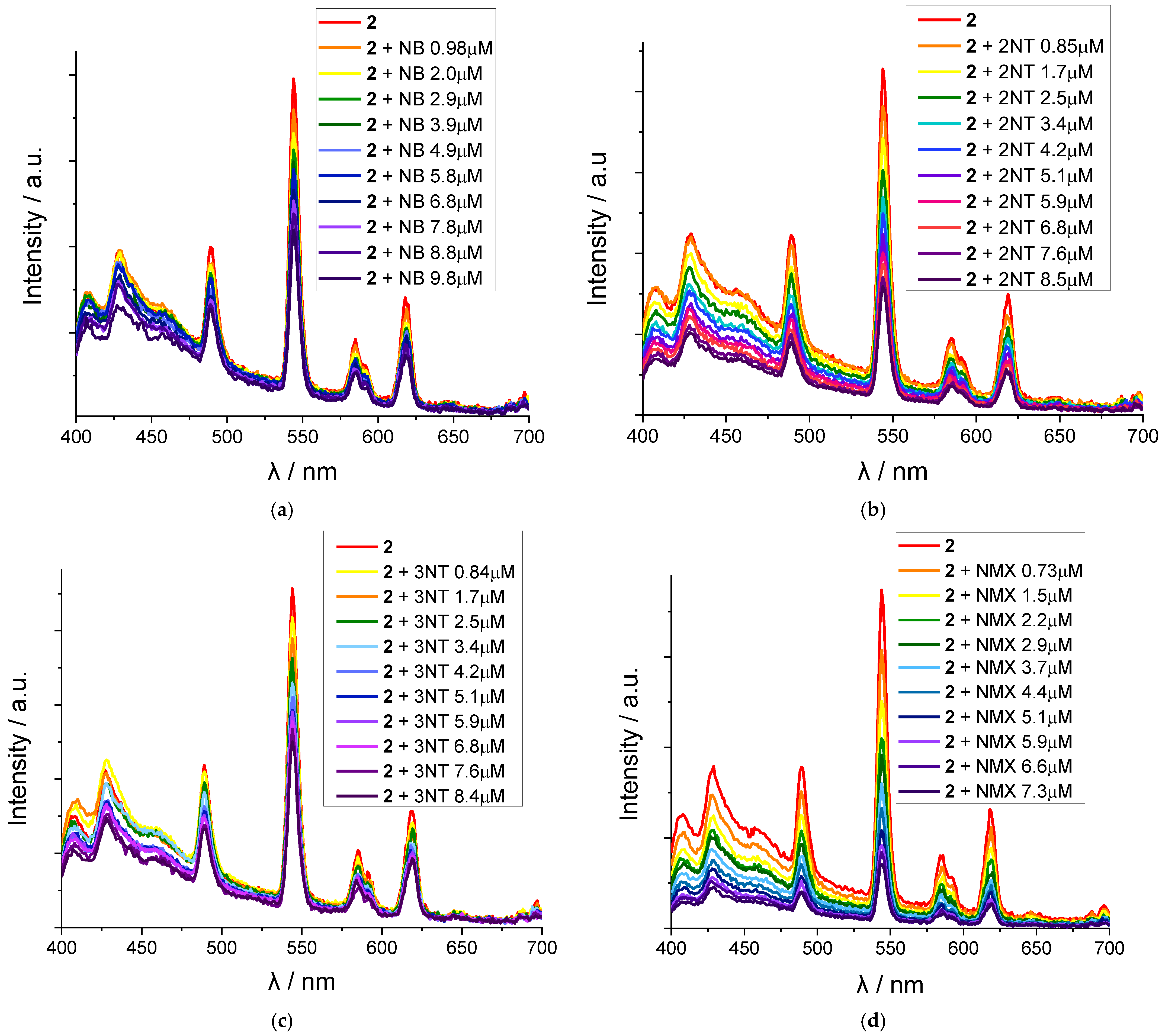
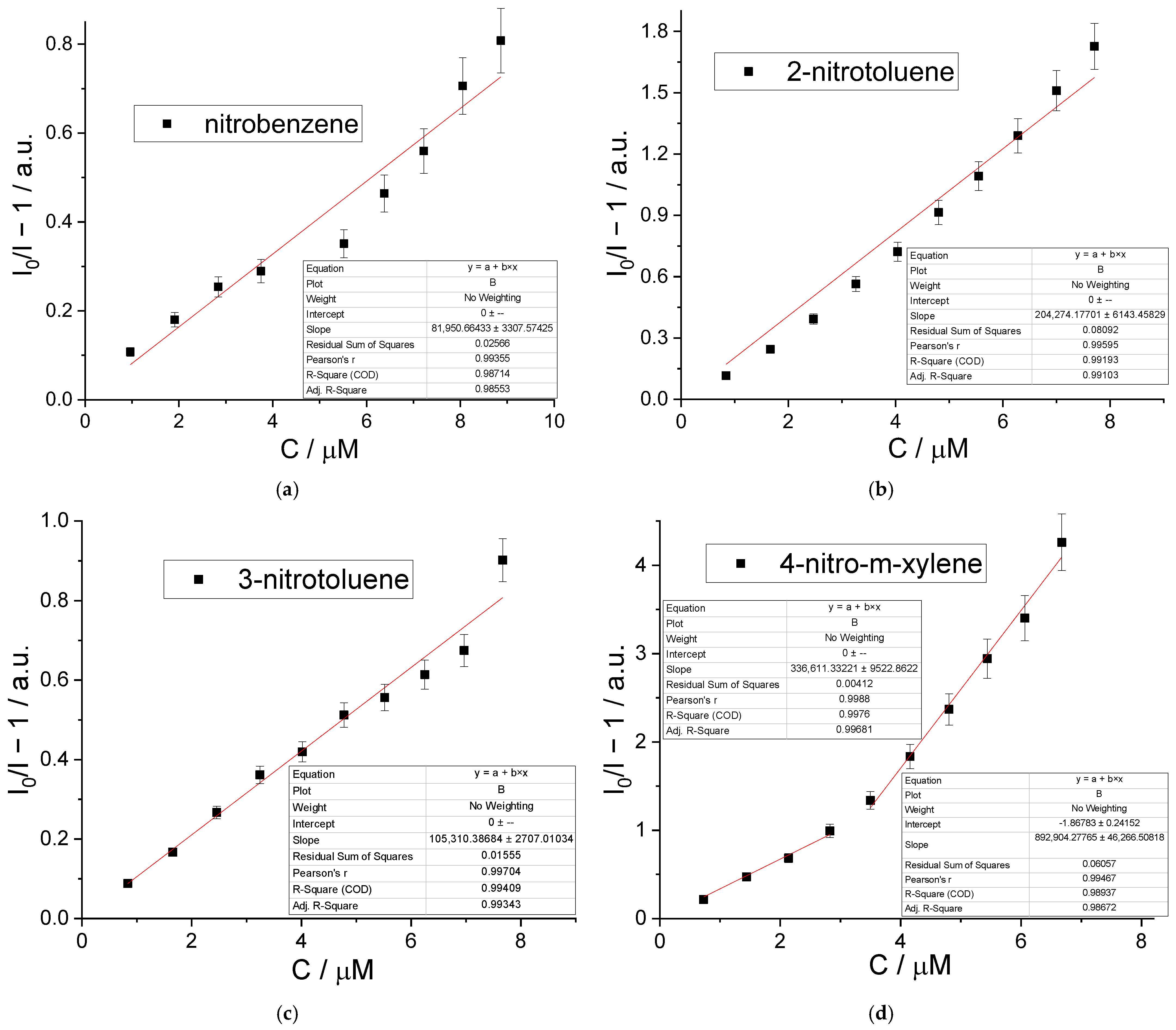
Disclaimer/Publisher’s Note: The statements, opinions and data contained in all publications are solely those of the individual author(s) and contributor(s) and not of MDPI and/or the editor(s). MDPI and/or the editor(s) disclaim responsibility for any injury to people or property resulting from any ideas, methods, instructions or products referred to in the content. |
© 2024 by the authors. Licensee MDPI, Basel, Switzerland. This article is an open access article distributed under the terms and conditions of the Creative Commons Attribution (CC BY) license (https://creativecommons.org/licenses/by/4.0/).
Share and Cite
Ovchinnikova, A.A.; Demakov, P.A.; Ryadun, A.A.; Fedin, V.P.; Dybtsev, D.N. Structures and Luminescent Sensing Properties of Terbium Metal–Organic Frameworks with Methyl-Decorated Phenanthroline Ligand. Crystals 2024, 14, 1026. https://doi.org/10.3390/cryst14121026
Ovchinnikova AA, Demakov PA, Ryadun AA, Fedin VP, Dybtsev DN. Structures and Luminescent Sensing Properties of Terbium Metal–Organic Frameworks with Methyl-Decorated Phenanthroline Ligand. Crystals. 2024; 14(12):1026. https://doi.org/10.3390/cryst14121026
Chicago/Turabian StyleOvchinnikova, Anna A., Pavel A. Demakov, Alexey A. Ryadun, Vladimir P. Fedin, and Danil N. Dybtsev. 2024. "Structures and Luminescent Sensing Properties of Terbium Metal–Organic Frameworks with Methyl-Decorated Phenanthroline Ligand" Crystals 14, no. 12: 1026. https://doi.org/10.3390/cryst14121026
APA StyleOvchinnikova, A. A., Demakov, P. A., Ryadun, A. A., Fedin, V. P., & Dybtsev, D. N. (2024). Structures and Luminescent Sensing Properties of Terbium Metal–Organic Frameworks with Methyl-Decorated Phenanthroline Ligand. Crystals, 14(12), 1026. https://doi.org/10.3390/cryst14121026









